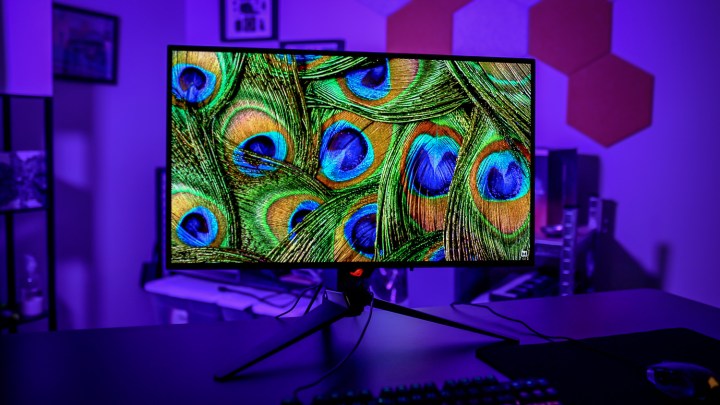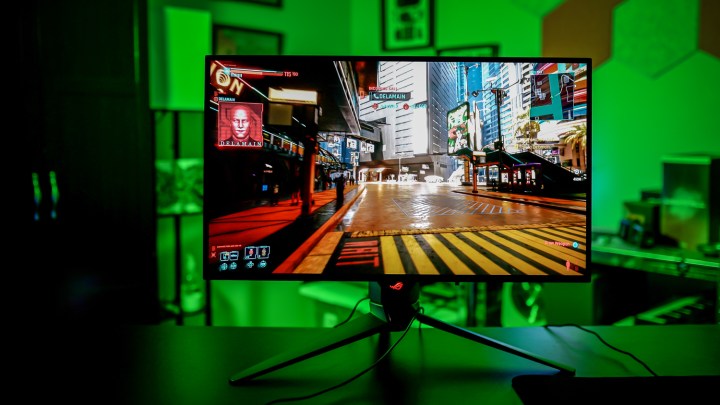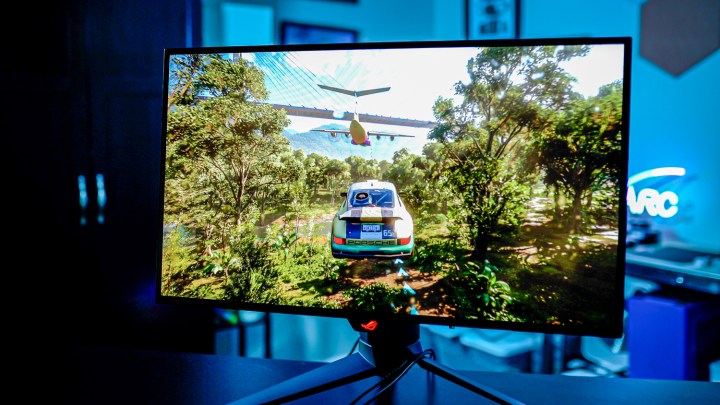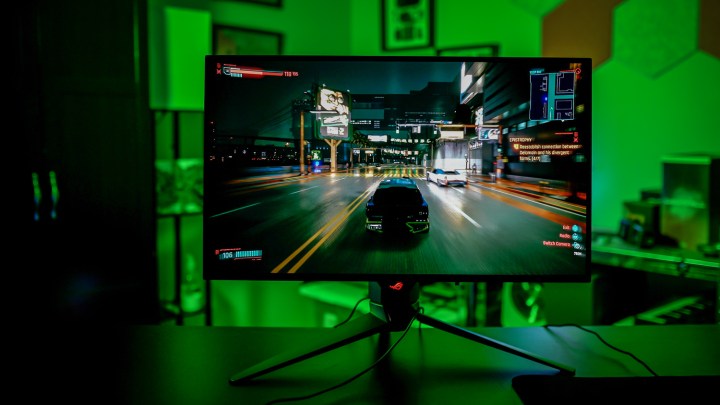
“OLED gaming monitors continue to impress, but the brightness of the Asus ROG PG27AQDM is what stands out.”
- Top-tier cinematic and competitive gaming
- Much brighter than other OLEDs
- Striking signature ROG design
- DisplayWidget Center
- Poor color accuracy out of the box
- OLED isn't great for desktop use
It didn’t take long for the few OLED monitors we’ve seen to claim positions among the best gaming monitors, but now we have an exciting advancement — Asus’ take on this emerging panel tech. The PG27AQDM looks like just another 27-inch OLED gaming monitor, but it does a lot to improve on the design LG debuted earlier this year.
On the surface, Asus managed to improve the brightness, which was the main criticism of LG’s take on a 27-inch OLED. But the PG27AQDM goes beyond that with a more robust range of features and the signature flair ROG monitors are known for.
Asus ROG Swift OLED (PG27AQDM) specs

| Asus ROG Swift OLED (PG27AQDM) | |
| Screen size | 26.5 inches |
| Panel type | OLED |
| Resolution | 2,560 x 1,440 |
| Peak brightness | 450 nits (SDR), 1,000 nits (HDR) |
| HDR | Yes |
| Local dimming | 3,686,400 zones |
| Contrast ratio | 1,500,000:1 |
| Response time | 0.03ms (GtG) |
| Refresh rate | 240Hz |
| Curve | No |
| Speakers | N/A |
| Inputs | 1x DisplayPort 1.4, 2x HDMI 2.0 |
| Ports | 2x USB 3.2 Gen 1 Type-A, 3.5mm headphone |
| Adjustments | 60 degrees swivel, 180 degrees pivot, 25 degrees tilt, 4.3 inches height |
| List price | $1,000 |
Striking ROG design

The ROG Swift OLED looks amazing, but that shouldn’t come as a surprise. Asus makes some beautiful-looking monitors, and the ROG Swift OLED brings some much-needed style to the growing world of OLED gaming displays.
It sports Asus’ signature tripoint stand, which includes a soft underglow that shines the ROG logo under the elevated monitor. There’s also an ROG logo on the back that lights up like Asus’ AniMe matrix on laptops such as the Zephrus M16, as well as a frameless design. There’s still a bezel, but there’s virtually no frame around the monitor.

Combin all that with how thin the panel is, and the ROG Swift OLED feels like a futuristic gaming monitor. Asus furthers that feeling with a few unique features. For example, there’s a 1/4-inch thread on the top of the stand if you want to mount a camera, similar to the Asus ROG PG42UQ.
Asus actually took some lessons from that larger 42-inch OLED as well. The heat sink inside, according to Asus, leads to 5% lower temperatures, with a 17% increase in brightness compared to the PG42UQ. I don’t have the PG42UQ on hand to compare, but I can say that the active cooling in the ROG Swift OLED was never audible during my testing.
Better control

There isn’t anything too exciting going on with the ports of the ROG Swift OLED 27. You have two HDMI 2.0 ports, along with a single DisplayPort 1.4 connection. You’ll want to use the DisplayPort connection if you can — HDMI 2.0 locks the monitor to 120Hz.
You also get a couple of USB 3.2 Gen 1 connections and a 3.5mm headphone jack through the USB-B port. Even if you don’t need the USB hub, you should hook up the USB-B cable for DisplayWidget Center.
DisplayWidget Center is a great addition to the ROG Swift PG27AQDM.
Asus took some notes from monitors like the Sony InZone M9 and developed DisplayWidget Center. It’s an app that allows you to control all of the settings of your monitor from your desktop, including the OLED panel care settings.
It’s a great addition, but you don’t need to use DisplayWidget Center if you don’t want to mess with the extra cables. The four-way joystick is easily accessible, and Asus has a clean and concise on-screen display. Thankfully, there are dedicated power and input buttons alongside the joystick, so you don’t need to fiddle with pushing it every direction to find what you need.
The brightness solution

The ROG Swift OLED comes with the same panel as the LG UltraGear OLED 27, so it inherits a lot of the same qualities. Asus goes a little further, though, bumping up the brightness by a significant margin.
That was the biggest criticism of LG’s take — it was too dim. I measured a peak brightness of just 204 nits on the LG monitor, while the ROG Swift OLED reached 297 nits of peak brightness. That’s far lower than what Asus advertises, but that shouldn’t come as a surprise. OLEDs are much dimmer than LCD monitors like the Samsung Odyssey Neo G8.
The brightness is significantly higher than what LG showed off earlier this year.
That’s around the brightness of the Alienware 34 QD-OLED in SDR — but keep in mind that QD-OLED is mainly impressive because of its brightness advantage over OLED. HDR is where the ROG Swift OLED gets interesting, though.
As usual, the display doesn’t reach 1,000 nits across the full screen. It gets close with a 3% window, though, topping out at 931 nits and validating Asus’ brightness claims. Stretch that out to a 25% window, and the brightness shrinks to 406 nits. It’s still not the brightness of a high-end LCD, but the brightness is significantly higher than what LG showed off earlier this year.

Brightness and contrast are the best part of the OLED quality; remember, OLED allows every pixel to reach true black levels, theoretically offering infinite contrast. Color is a different story entirely, and that’s where the ROG Swift OLED struggles.
In SDR, the color coverage is solid with 97% DCI-P3 and 91% AdobeRGB, but the color accuracy is all over the place. Out of the box, the blues and reds were way off, resulting in a color difference of 9 (most monitors aim for less than 2). Asus claims the monitor comes calibrated, but my results say otherwise. HDR performance is worse, as is expected from an OLED panel with a white subpixel.
The good news is that this is an issue with the calibration of the monitor, not the panel itself. Using the SpyderX, I was able to achieve a 1.3 color difference, which is more than acceptable for a panel of this caliber. During my review period, Asus released a firmware update to improve HDR color accuracy, which helped, so hopefully a future update can improve default color performance even more. The sRGB mode on the monitor is fairly accurate, so you can limit the monitor to that color space.

That only really matters if you want to do content creation. The default color profile is technically wrong, but it still looks great. I played through some of Cyberpunk 2077‘s new Overdrive mode with the default profile, and I had to pull myself away from it to write this review. It looks fantastic, but if you want to do some video or photo editing, a significant calibration is in order.
OLED woes
The ROG Swift OLED looks great, and with calibration, you can use it for content creation. OLED comes with some problems, though, and the ROG Swift OLED isn’t above those issues.
First is burn-in. OLED burn-in risks are overblown, even on a desktop monitor, but it’s still something to keep in mind if you want to use the monitor primary for desktop use. This is a slightly more prominent issue on the ROG Swift OLED because it can get brighter. Static images at high brightness for a long period of time lead to a higher risk of burn-in, and I saw slight hints of image retention even during my review period.
Asus includes a ton of migration features. By default, you’ll get a notification after every eight hours of consecutive use to run the pixel-cleaning feature, but Asus goes further. There’s an automatic screen saver, along with a setting that will automatically dim static logos. There’s always a small risk of burn-in, but some minor upkeep will keep the ROG Swift OLED operating for years into the future.

If anything, the more pressing issue is the WRGB subpixel layout. This is a problem that showed up on the Alienware 34 QD-OLED and the LG UltraGear OLED 27, and it comes down to text clarity. In short, there’s a bit of fringing on text due to the extra white subpixel.
It’s not an issue for me, even on a 27-inch, 1440p screen that’s sitting fairly close to my face. However, this is definitely something that comes down to preference, and you may find it to be a problem if you’re looking at text all day. For my part, I have no issues with text clarity, and I use the Alienware 34 QD-OLED every day to write articles.
Best of both worlds gaming

The HDR experience on the ROG Swift OLED 27 is fantastic, especially in cinematic titles like Cyberpunk 2077. It goes beyond great HDR due to the low response times of OLED. Asus claims 0.03 milliseconds, and although the monitor is closer to 0.2ms, it’s still one of the fastest response times you can get out of a monitor right now.
Even the fastest LCDs only get to 1ms. Combined with the 240Hz refresh rate, you’re getting exceptional motion clarity that’s only rivaled by esports displays like the Alienware AW2524H. Games like Cyberpunk 2077 or Forza Horizon 5 look fantastic with HDR turned on, and the ROG Swift OLED is fast enough that you can compete in games like Overwatch 2 and Valorant.

Beyond the motion clarity, the monitor supports Adaptive Sync, allowing you to use G-Sync with Nvidia GPUs and FreeSync with AMD GPUs. Asus includes a few additional settings, such as a frames-per-second (fps) counter, timer, and genre-specific presets, but I imagine they won’t be selling points for most users.
The gaming experience on the ROG Swift OLED is one of the best you can buy right now, combining the excellent motion clarity of an esports monitor and the world-class HDR performance of OLED. It’s only matched by the Alienware 34 QD-OLED and LG UltraGear OLED 27, and Asus has a few key areas where it has made improvements.
Should you buy the Asus ROG Swift PG27AQDM?

We’ve already seen what a 27-inch OLED gaming monitor can do, but the ROG Swift OLED 27 builds on the design LG cemented with higher brightness and a more robust range of features. Color accuracy is a killer out of the box, but hopefully Asus can further address color issues with future firmware updates.
Among the two 27-inch OLED monitors we currently have, this is the one to buy. However, the Alienware 34 QD-OLED still poses a huge threat to the ROG Swift OLED 27. The Alienware monitor has better color performance before calibration, and it’s around the same price Asus is charging. Between the two monitors, I’d still pick the Alienware, but it’s easy to justify the Asus if you’re not into a 21:9 aspect ratio.
There’s no doubt the ROG Swift OLED 27 is competing with the best gaming monitor you can buy right now. However, it’s important to remember that OLED isn’t for everyone. As impressive as it is for both cinematic and competitive gaming, if you find yourself primarily doing work on a desktop, an LCD display will serve you better.
Editors' Recommendations
- Asus’ forgotten ROG Ally is now totally worth the money
- CES 2023: Asus’ new 27-inch OLED monitor hits the sweet spot for gamers
- LG finally did it: a 27-inch OLED gaming monitor with a 240Hz refresh rate
- The ROG Swift PG42UQ is the 42-inch OLED gaming monitor I’ve been waiting for
- Asus stuffs AMD Ryzen 5000 chips into its ZenBook 13 OLED and 14




